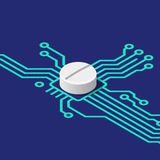Paper:
https://www.nature.com/articles/s41586-023-06728-8
Github:
https://github.com/generatebio/chroma
Colab Notebook:
https://colab.research.google.com/github/generatebio/chroma/blob/main/notebooks/ChromaDemo.ipynb
https://www.nature.com/articles/s41586-023-06728-8
Github:
https://github.com/generatebio/chroma
Colab Notebook:
https://colab.research.google.com/github/generatebio/chroma/blob/main/notebooks/ChromaDemo.ipynb
Nature
Illuminating protein space with a programmable generative model
Nature - Evolution has produced a range of diverse proteins, and now a generative model called Chroma can expand that set by allowing the user to design new proteins and protein complexes with...
AI for Drug Discovery & Development
Paper: https://www.nature.com/articles/s41586-023-06728-8 Github: https://github.com/generatebio/chroma Colab Notebook: https://colab.research.google.com/github/generatebio/chroma/blob/main/notebooks/ChromaDemo.ipynb
YouTube
Broad Institute Machine Learning in Drug Discovery Symposium 2023: Gevorg Grigoryan
PROGRAMMABLE GENERATIVE PROTEIN DESIGN
Gevorg Grigoryan
CTO, Generate Biomedicines
This event is sponsored by -
Platinum Sponsor: WuXi AppTec - https://www.wuxiapptec.com
Gold Sponsor: Tandem AI - https://tandemai.com
Silver Sponsor: Cellarity - https://cellarity.com…
Gevorg Grigoryan
CTO, Generate Biomedicines
This event is sponsored by -
Platinum Sponsor: WuXi AppTec - https://www.wuxiapptec.com
Gold Sponsor: Tandem AI - https://tandemai.com
Silver Sponsor: Cellarity - https://cellarity.com…
https://www.biorxiv.org/content/10.1101/2024.01.03.573985v1
🔴 Phenotype-driven drug discovery, as an emerging alternative to target-driven strategies, identifies compounds that counteract the overall effects of diseases by analyzing phenotypic signatures. Our study introduces a novel approach to this field, aiming to expand the search space for new therapeutic agents.
🔴 We introduce PDGrapher, a causally-inspired graph neural network model designed to predict arbitrary perturbagens – a set of therapeutic targets – capable of reversing disease effects. Unlike current methods, which are limited by their reliance on predefined compound libraries, PDGrapher employs a novel combinatorial prediction framework to widen the search scope.
🔴 PDGrapher has demonstrated significant improvements in predicting effective perturbagens, as evidenced by our evaluation across four datasets of genetic and chemical perturbations. PDGrapher successfully predicted effective perturbagens in up to 10% additional test samples and ranked known therapeutic targets up to 35% higher than competing methods.
🟢 A key innovation of PDGrapher is its direct prediction capability, which contrasts with the indirect, computationally-intensive models traditionally used in phenotype-driven drug discovery that only predict changes in phenotype that occur as a result of a perturbation. The direct approach enables PDGrapher to train up to 30 times faster, representing a significant leap in efficiency. Our results suggest that PDGrapher can advance phenotype-driven drug discovery, offering a fast and comprehensive approach to identifying therapeutically useful perturbations.
🔴 Phenotype-driven drug discovery, as an emerging alternative to target-driven strategies, identifies compounds that counteract the overall effects of diseases by analyzing phenotypic signatures. Our study introduces a novel approach to this field, aiming to expand the search space for new therapeutic agents.
🔴 We introduce PDGrapher, a causally-inspired graph neural network model designed to predict arbitrary perturbagens – a set of therapeutic targets – capable of reversing disease effects. Unlike current methods, which are limited by their reliance on predefined compound libraries, PDGrapher employs a novel combinatorial prediction framework to widen the search scope.
🔴 PDGrapher has demonstrated significant improvements in predicting effective perturbagens, as evidenced by our evaluation across four datasets of genetic and chemical perturbations. PDGrapher successfully predicted effective perturbagens in up to 10% additional test samples and ranked known therapeutic targets up to 35% higher than competing methods.
🟢 A key innovation of PDGrapher is its direct prediction capability, which contrasts with the indirect, computationally-intensive models traditionally used in phenotype-driven drug discovery that only predict changes in phenotype that occur as a result of a perturbation. The direct approach enables PDGrapher to train up to 30 times faster, representing a significant leap in efficiency. Our results suggest that PDGrapher can advance phenotype-driven drug discovery, offering a fast and comprehensive approach to identifying therapeutically useful perturbations.
bioRxiv
Combinatorial prediction of therapeutic perturbations using causally-inspired neural networks
Phenotype-driven drug discovery, as an emerging alternative to target-driven strategies, identifies compounds that counteract the overall effects of diseases by analyzing phenotypic signatures. Our study introduces a novel approach to this field, aiming to…
This media is not supported in your browser
VIEW IN TELEGRAM
رادیولوژی در مسابقه هوش مصنوعی در مراقبت های بهداشتی برنده واضح است!
فقط یک دهه پیش، دستگاه های پزشکی با هوش مصنوعی که توسط نهادهای نظارتی تایید شده بودند، یک چیز جدید بودند.
اما در سال های اخیر، آنها شتاب قابل توجهی به دست آورده اند. سازمان غذا و داروی ایالات متحده (FDA) این روند را از نزدیک رصد کرده است و تعداد دستگاه های مبتنی بر هوش مصنوعی تایید شده توسط FDA در یک سال از 650 به 950 افزایش یافته است.
برای تجسم این رشد سریع، ما یک ویدیوی کوتاه ایجاد کرده ایم که افزایش پویا در تایید دستگاه در ده سال گذشته را با تمرکز بر هر تایید در تخصص های پزشکی برتر برجسته می کند.
فقط یک دهه پیش، دستگاه های پزشکی با هوش مصنوعی که توسط نهادهای نظارتی تایید شده بودند، یک چیز جدید بودند.
اما در سال های اخیر، آنها شتاب قابل توجهی به دست آورده اند. سازمان غذا و داروی ایالات متحده (FDA) این روند را از نزدیک رصد کرده است و تعداد دستگاه های مبتنی بر هوش مصنوعی تایید شده توسط FDA در یک سال از 650 به 950 افزایش یافته است.
برای تجسم این رشد سریع، ما یک ویدیوی کوتاه ایجاد کرده ایم که افزایش پویا در تایید دستگاه در ده سال گذشته را با تمرکز بر هر تایید در تخصص های پزشکی برتر برجسته می کند.
So it begins!
Considerations for the Use of Artificial Intelligence To Support Regulatory Decision-Making for Drug and Biological Products
https://www.fda.gov/regulatory-information/search-fda-guidance-documents/considerations-use-artificial-intelligence-support-regulatory-decision-making-drug-and-biological
Considerations for the Use of Artificial Intelligence To Support Regulatory Decision-Making for Drug and Biological Products
https://www.fda.gov/regulatory-information/search-fda-guidance-documents/considerations-use-artificial-intelligence-support-regulatory-decision-making-drug-and-biological
U.S. Food and Drug Administration
Considerations for the Use of Artificial Intelligence To Support Regulatory Decision-Making for Drug and Biological Products Draft…
Considerations for the Use of Artificial Intelligence To Support Regulatory Decision-Making for Drug and Biological Products
